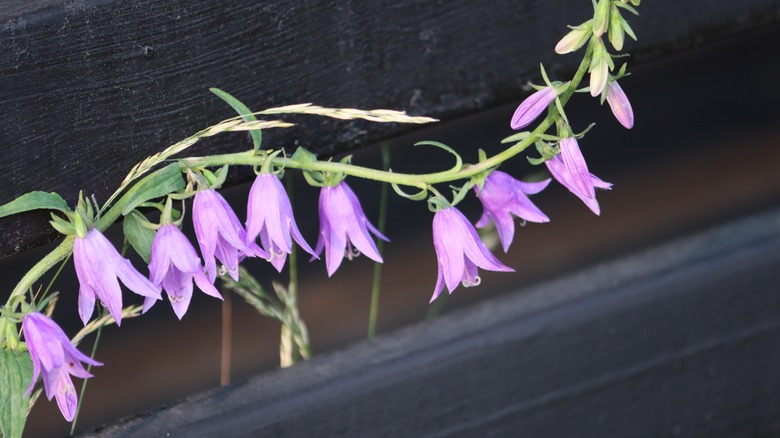You'll Regret Planting This Gorgeous Flower In Your Yard
When looking for packets of seeds at the garden center you may be drawn to wildflowers that include many different plant species. Unfortunately, sometimes these packets contain a terrible surprise — creeping bellflower. Creeping bellflower (also known as European bellflower, rampion bellflower, and roving bellflower) is a weed and invasive plant originally brought to North America from Europe. While most nurseries and garden centers don't sell this flower species anymore, it is easy to accidentally purchase the plant in mixed seed packets or have it gifted to you by unaware friends.
The reason this invasive plant was originally brought to the U.S. was for the beauty of its purple bell-shaped flowers and ability to grow just about anywhere — from cracks in cement to completely shaded and wet soil. However, the issue with creeping bellflower is that it spreads quickly, grows fast, and is so difficult to get rid of that some have dubbed it "the purple menace." In fact, creeping bellflower is so good at spreading and reproducing that it can choke out your entire garden and take over your yard. The issue with creeping bellflower is that it is hard to identify at first because it looks similar to many other plants and you may not even know you have it until it's too late.
How to recognize creeping bellflower
Firstly, to try and keep creeping bellflower out of your yard, when purchasing packets of wildflower seeds make sure to check the species list for all the possible names of creeping bellflower including its Latin name: Campanula rapunculoides. There are a couple of North American native bellflower species that look similar to creeping bellflower but aren't invasive. These include harebells or bluebells (Campanula rotundifolia) and ladybells (Adenophora liliifolia) which both have similar shades of purple flowers that dangle off of their stalks like bells.
Because of the similarities between the leaves of these different species, you may need to wait for the plant to flower to accurately identify it as a creeping bellflower and not a native bluebell. To tell the difference, you should look at where the flowers grow on the stalks. On the invasive creeping bellflowers, the flowers grow all the way up one side of the stalk. For native bluebells or harebells, the flowers all grow together in a cluster at the top of the stalk which often causes the plant to lean over from the weight of the blooms. Another way to tell if you have the invasive bellflower is if it starts quickly spreading throughout your yard and new shoots are popping up everywhere.
How to get rid of the purple menace
Once you have a creeping bellflower in your yard, it's an uphill battle to get rid of it and the process will require plenty of vigilance and patience. As one frustrated gardener on Reddit put it, "This is my third year in this house and I pull and dig and pull and dig ... [but] this horrible plant keeps popping up in different places all over my yard."
Many people battling creeping bellflower go through the same experience and the reason behind it is that the plant is a tuber that grows an extensive root system. The roots of creeping bellflower can grow up to 12 inches deep and easily break when pulled leaving behind small root pieces that will simply regrow into new plants. This is why pulling the plants alone is often ineffective and many sources recommend digging creeping bellflower out with a shovel.
Unfortunately, creeping bellflower is also resistant to some herbicides like 2,4-D. Luckily, other herbicides like Banvel, Roundup, and Tordon K can be up to 70% to 90% effective when applied to the leaves of the plants during the budding stage in early spring, per the University of Wisconsin. However, for herbicides to truly work, they may need to be applied multiple times during the growing season. You may also have to treat the plants with herbicides for multiple years to completely get rid of them.


